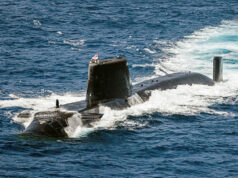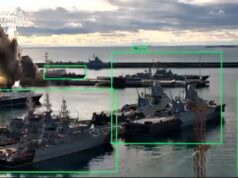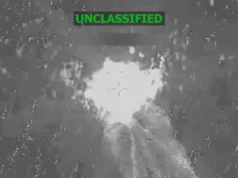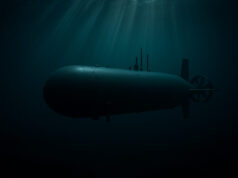Babcock has secured a six-year contract to provide in-service support for the Tomahawk Land Attack Missile (TLAM), according to a contract notice published by the Ministry of Defence.
The contract, valued at £1.295 million, will run from 21 October 2024 to 31 October 2030, and builds upon Babcock’s previous work supporting the TLAM system, which dates back to a 3.5-year programme beginning in 2019.
According to the contract notice, this award covers “the in-service support of Tomahawk land attack missile systems” and was granted following a competitive tendering process.
The contract highlights Babcock’s proven capability in managing complex weapons systems, including TTWCS, as well as providing project and configuration management, specialised test equipment maintenance, and technical support.
Babcock commented back in 2019 on the awarding of the previous contract of this time, saying during the previous contract announcement: “Weapons systems are our speciality and this contract will enable both Babcock and Lockheed Martin to drive critical programme elements through a collaborative framework for our customer.”
With this new six-year contract in place, Babcock will continue to play a crucial role in ensuring the operational readiness and reliability of the Royal Navy’s TLAM systems well into the rest of this decade.
What is Tomahawk?
The American-built Tomahawk missile, also known as TLAM, allows Royal Navy submarines of the Astute and Trafalgar class to strike at targets on land accurately at a range of around 1,000 miles. The missile is a highly accurate, GPS-enabled weapon that the US and allied militaries have used more than 2,000 times in combat, and flight-tested 500 times say the manufacturer.
In April 2017, US Navy destroyers launched 59 Tomahawk cruise missiles at targets on a Syrian air base. In 2014, a US Navy destroyer and a guided missile cruiser launched 47 Tomahawk missiles in a strike on the Islamic State terrorist group in Syria.

It’s important to remember that Tomahawk is a cruise missile, so rather than taking on a ballistic trajectory, it stays close to the ground, steering around terrain features, using a jet engine instead of a rocket engine to fly. It is hoped that by the missile keeping low—because of its small radar signature—the Tomahawk avoids radar-guided defences that can threaten manned aircraft.
The missile has been in use with the Royal Navy since the late 1990s and has been used in the Kosovo conflict and in the campaigns against the Taliban, Saddam Hussein and Gaddafi.
The missile is fired from a boat’s torpedo tubes. Once it reaches the surface, a booster rocket ignites to propel the missile skywards. Tomahawk then heads for its target at 550 mph, delivering a 1,000 lb explosive warhead.
The Tomahawk IV is the latest version of the missile operated by the British submarine fleet, the U.S Navy will soon operate the upgraded Block V which unlike this version, has anti-ship capabilities. It has a longer range than its predecessors and can be directed at a new target in-flight, and can also beam back images of the battlefield.
According to a US Navy factfile:
“Tomahawk cruise missiles are designed to fly at extremely low altitudes at high subsonic speeds, and are piloted over an evasive route by several mission tailored guidance systems. The first operational use was in Operation Desert Storm, 1991, with immense success. The missile has since been used successfully in several other conflicts.
In 1995 the governments of the United States and United Kingdom signed a Foreign Military Sales Agreement for the acquisition of 65 missiles, marking the first sale of Tomahawk to a foreign country. In 2003, an agreement was approved for the United Kingdom to procure 65 Block IV Torpedo Tube Launch Tomahawks. The United Kingdom began to receive Block IV missile deliveries in January 2008 and successfully declared their In-Service-Date in March 2008.”
At the time of writing, the most recent UK purchase was 65 of the missiles in July 2014. According to the builder, these are the general specifications:
| Primary Function: Long-range subsonic cruise missile for striking high value or heavily defended land targets. |
| Contractor: Raytheon Missile Systems Company, Tucson, AZ. |
| Date Deployed: Block II TLAM-A IOC – 1984 Block III – IOC 1994 Block IV – IOC 2004. |
| Propulsion: Block II/III TLAM-A, C & D – Williams International F107 cruise turbo-fan engine; ARC/CSD solid-fuel booster |
| Length: 20.3 feet; with booster: 20 feet 6 inches (6.25 meters). |
| Diameter: 21 inches |
| Wingspan: 8 feet 9 inches (2.67 meters). |
| Weight: 3,330 pounds with rocket motor. |
| Speed: Subsonic – about 550 mph (880 km/h). |
| Range: Block III TLAM-C – 900 nautical miles (1000 statute miles, 1600 km) Block III TLAM-D – 700 nautical miles (800 statute miles, 1250 km Block IV TLAM-E – 900 nautical miles (1000 statute miles, 1600 km) |
| Guidance System: Block II TLAM-A – INS, TERCOM Block III TLAM-C, D Block IV TLAM-E – INS, TERCOM, DSMAC, and GPS. |
| Warhead: Block II TLAM-N – W80 nuclear warhead. Block III TLAM-C and Block IV TLAM-E – 1,000 pound class unitary warhead. Block III TLAM-D – conventional submunitions dispenser with combined effect bomblets. |














Are UKs stocks to be updated to Block 5? Someone in a previous article here said such a plan existed though also claimed it would give us an anti ship capability. However reading up on this it’s a bit more complex than that surely as it’s the Va version that is for anti ship, the base V version is just an update and the Va has a much shorter range with its substantially re-arranged innards, so one has to ask is it even capable of being upgraded to this standard from Block lV or have to be newly produced, or at the very least a substantial and very expensive rebuild? Either way will we actually get Va?
Hi mate, from what I’ve read and understand, believe that our stocks are going to be/ are being upgraded to base line V version only. Don’t believe we have bought any more then what’s been stated.
Cheers, what I suspected.👍
Wonder whether any future purchases of Tomahawk will be dictated by compatibility requirements of Mk-41 VLS on T-26/T-31 and potentially, SSN-A?
Hi fella, sorry for late reply, but this only came through to me late last night!!!
Personally would have thought that if so, UK MOD would have started ball rolling with an order for some by now, albeit at a reduced supply rate? Think that they may well be a fall back option and that we are holding out for FC/ASM for both units, as believe that this is probably the preferred option of choice to kill the bad guys! Only time will tell, and indeed if it was the correct choice/price. Just my thoughts mate.
Understood, thanks. 👍
Interesting.
I though they were maintained at DM Beith. Are Babcock staff on site there?
They certainly used to be back in the days when I was serving
Ummm…sorry, but value of contract seems too low. £1.259Mn/6 Yrs. = £215.83K/Yr. Is that a realistic number for this effort? 🤔. (Not certain a contractor would even answer the phone for this price in the US.)
£1.3m 🤷 what are they making stickers for the sides, ☮️ 🏳️🌈 etc. etc 😁